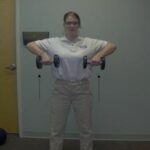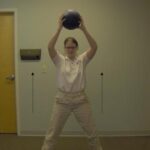For those fitness enthusiasts seeking broader, thicker shoulders and a full barrel chest from his training efforts, there are a couple of undeniably fundamental truths to consider. To begin with, one must understand the basic mechanics and functions of the chest and shoulders. The muscles of the chest, the anterior deltoids (front meaty part of shoulder), and the triceps enable us to extend our arms out in front of us. These are the muscles called upon anytime pushing a load is the task. On the flip-side, the muscles of the upper back and rear deltoids, as well as the biceps are utilized when the task requires pulling the load.
The second point to remember is that one’s chest routine should be complemented by an equivalent upper back routine. Without belaboring the point, building a massive chest while ignoring the muscles of the upper back can eventually lead to a myriad of health issues as we age. Balance in all one’s training efforts is essential for this purpose as much as any other.
Competitive athletes across a wide array of sporting activities rely heavily upon the strength and / or power that the thick musculature of the chest provides. Football and basketball players alike, as well as wrestlers and fighters (boxing and mixed martial arts) and too many more to mention here depend upon upper body strength in the performance of his or her activity. The following chest routine can be performed as half of a chest / back session, or in conjunction with triceps training. For purposes of example, and because this trainer believes in training agnostic muscles together, the session outlined below is a chest / back format. Each exercise grouping noted below is comprised of 2 sets of antagonistic movements per and are meant to be performed in superset fashion; in other words, don’t rest between the exercises more than time needed to move to the next exercise.
Quad 1:
Flat-bench press-This exercise will work the chest overall, as well as the anterior deltoids and triceps and is generally performed with a straight-bar or dumbbells.
Bent over barbell rows-This is essentially the opposite exercise of the flat-bench press and works the rear deltoids, biceps, and thick lat muscles. Typically performed with a straight-bar, this exercise may also be performed at a t-bar row station that is designed to completely support the body as one is bent over in a modified prone position.
Incline bench press-This exercise is performed essentially the same as the flat-bench press with two notable differences. An incline bench is needed for this exercise and it is typically performed with a straight bar (significantly lighter than one would use on a flat-bench press as the delicate muscles of the shoulder are more taxed in this movement), or dumbbells. This particular variation of the bench press will place emphasis on the upper chest.
Lat pulldowns-The lat pulldown will work the thick lat muscles primarily, and the rear deltoids, as well as the biceps secondarily. This particular upper back exercise is performed with the use of a lat tower high-cable. There are typically a good variety of grips or handles one can use in performing the lat pulldown. Once again, each grip poses its own unique stimulus to the exercise. Shake it up a little from time to time.
Conventional pushups-At the conclusion of the lat pulldown set, perform one set of conventional pushups to near failure. The idea behind the pushups is to provide the chest with a great supplemental burn, as well as promoting increased muscular endurance in the chest, shoulders, and triceps. After one completes this set, rest for a couple of minutes before plowing through the following sets.
Quad 2:
Decline bench press-This variation of the bench press will place the emphasis on development of the lower portion of the pecs. One needs to be particularly aware of form while performing this movement due to the angle of the body. Blood has a tendency to rush to the head so be conscious of your breathing patterns (exhale fully on exertion and inhale deeply on return-do not hold your breath).
Seated rear deltoid rows-Perform this exercise at the low-cable row station (typically located at the back side of the lat pulldown station). Sit at the station with the legs extended in front and back straight. Grasp the handle with the arms fully extended (a straight handle or hammer grip handle may be used to slightly alter the training stimulus) and pull to the chest. This movement works the rear deltoids, as well as the lats, with the biceps receiving some of the work also.
Cable crossovers-A particularly effective movement for blasting the lateral area of the chest, this exercise is performed at the crossover station designed specifically for this type of movement. For added variety and slightly different stimulus, one can use either the high or low cables to perform this exercise. One may choose to work the high cable on the first set, followed with a low cable set the next time.
Single bent over dumbbell rows-Another excellent movement for punishing the rear delts and lats, with the biceps getting involved as well. This exercise is performed with the use of a flat bench typically supporting the body as the working arm pulls or ‘rows’ the dumbbell to the chest level. The bench is essential for support here as the exerciser is bent over at the waist until the upper body is nearly parallel to the floor.
Conventional pushups-Perform another set of standard pushups to near failure.
For maximal results, the above routine should be completed a minimum of 2-3 times per training session. Keep in mind that in order to pack on serious muscle and strength gains, this routine will be performed at a high-intensity level. Perform 6-10 heavy repetitions per set with the exception of the pushup sets. The pushup sets should be performed to near failure until the last set, which should be performed to muscle failure.
Of course there are several exercises and variations of that one could substitute for any of those listed here. Past articles that I have written have discussed the importance of variation in a fitness routine at length. Variation is one of the keys to ensuring that the body remains in the shock phase of active growth.
For example, when one performs a close-grip bench press as opposed to the standard shoulder width or slightly better technique, the triceps, as well as the inner chest shoulder more of the load. A wider grip takes some of the stress off the triceps and concentrates the emphasis on the outside area of the chest. I encourage all my clients and anyone else whom I advise on fitness to change hand placement, grip handles, and other little subtle changes that alter the training stimulus periodically in order to avoid staleness in the routine. One can alter the training stimulus in his or her routine simply by flip-flopping the order of exercises performed in a training session every so often, or by switching from using a straight-bar to heavy dumbbells instead. These are just a couple of tactics that keep the routine fresh. Other examples of exercises that work the muscles of the chest predominantly are listed below.
Flat-bench flyes- This exercise is performed with a flat bench and either dumbbells or the low cables on the cable crossover machine. Bear in mind that the delicate muscles of the rotator cuff are under significant stress during this exercise, so proceed with caution and sound judgment. The resistance one begins with should be relatively light until the muscles of the shoulder become accustomed to the movement in order to avoid injury. This particular exercise works the entire chest but can be instrumental in the lateral development of the pecs.
Pullovers-There are machines designed for this purpose or one can use a flat-bench and either a straight bar or a single heavy dumbbell. Another good chest isolation exercise when performed with the arms slightly bent at the elbows, pullovers can be dangerous if performed irresponsibly. The movement carries the weight overhead until the arms are extended over the chest.
Chest dips-These are generally performed in the gym at the dip station designed for this exercise. The triceps are also involved in this movement. Dips can be performed with a sturdy bench and can be a very effective body-weight exercise.
One can plainly see that one’s options are nearly endless with all the variations of exercises that work the chest. There are a plethora of exercises not listed here that work the muscles of the chest. The above routine may be used as outlined or used as a point of reference. Don’t be afraid to substitute other chest exercises for those noted above.
The key in building the barrel chest is intensity. Regardless of the particular exercises that one decides to use, if the goal is a larger and fuller chest, then one needs to utilize moderately heavy resistance (6-10 repetitions maximum per set) for a minimum of two to three sets per exercise, per session. It bears mentioning once more that one’s results are always relative to one’s efforts. Good luck and as always, happy training!







